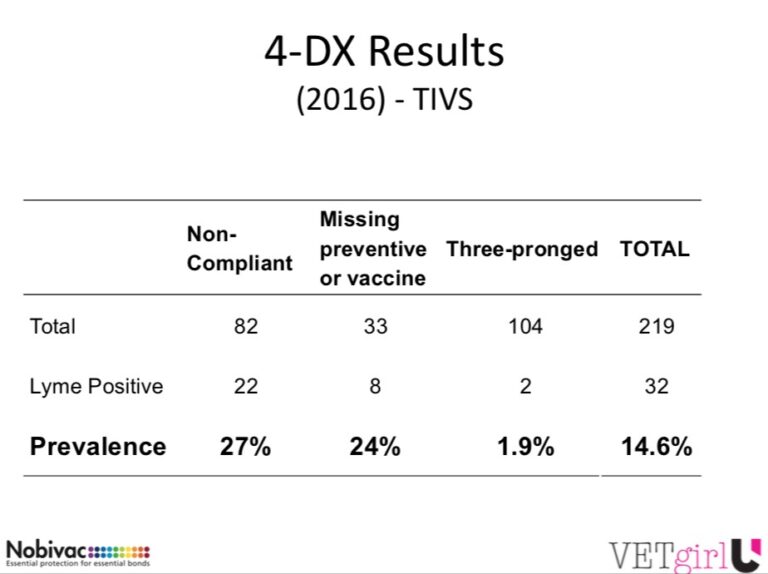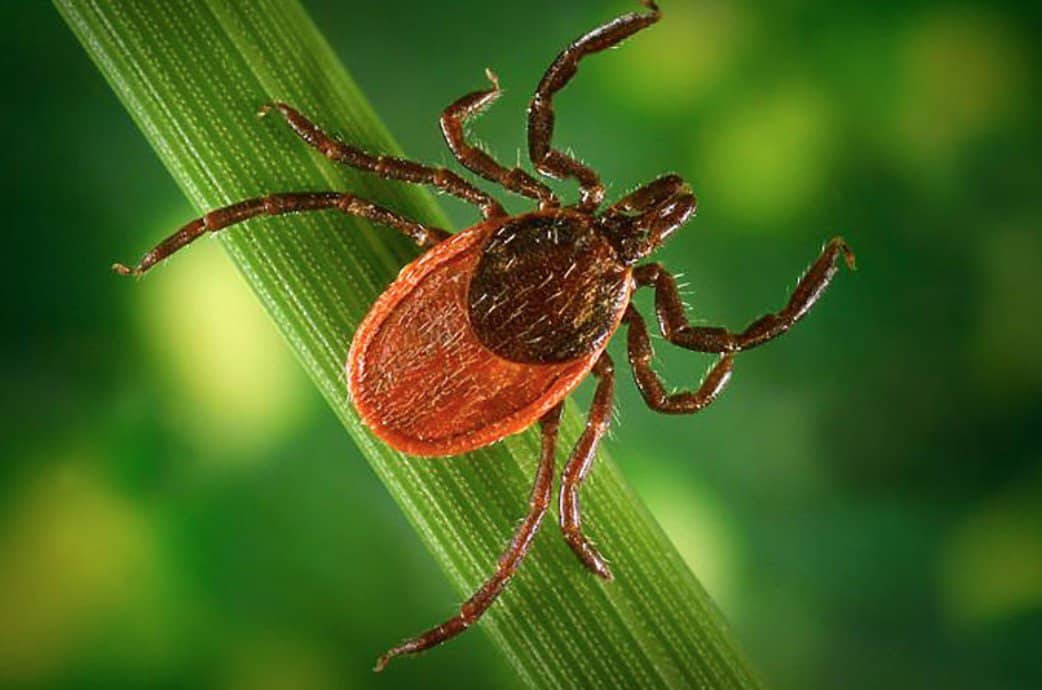Since I am a small animal veterinarian, I see a lot of dogs with ticks and sadly, some dogs who are infected with tick-borne disease like Lyme. With a few specific preventive measures, the chance of your dog obtaining a disease from a tick is very low. Conversely, if you don’t take some specific precautions, the risk is significantly higher.
Just how Many Diseases do Ticks Carry?
Not to geek out on you too much, but did you know that ticks can transmit a lot more than just Lyme disease? In fact, there are seven major tick-borne diseases in the United States alone. Here’s a brief run down of them:
• Lyme disease
• Canine Ehrlichiosis
• Canine Anaplasmosis
• Rocky Mountain Spotted Fever
• Canine Babesiosis
• Canine Bartonellosis
• Canine Hepatozoonosis
Lyme Disease gets all the attention these days and for good reason. The range of Lyme is quickly spreading which means that the number of cases diagnosed is also on the rise in both humans and animals. Much of what I focus on in this post will reference Lyme Disease and the species of ticks that transmit it (blacklegged or deer ticks–Ixodes scapularis and Ixodes pacificus), but most of the preventive measures apply to any kind of tick-borne disease.
Scientific Study for most effective tick prevention measures
The adage, “An ounce of prevention is worth a pound of cure” applies to all sorts of nasty parasites that prey on our furry friends such as heartworms, intestinal parasites, fleas, and ticks. If I had a nickel for every time I counseled clients on preventive measures for parasites, I could probably pay for all three of my kids to attend the most expensive colleges.
Each parasite comes with its own set of guidelines regarding best practices for prevention, and ticks are no exception. A small study was conducted recently to compare the efficacy of the recommended 3-pronged approach to tick prevention that involves:
- Client Education
- Oral/Topical Preventive
- Vaccination for Lyme Disease
Not surprisingly, the study group who implemented all three facets of prevention had significantly fewer Lyme-positive results (1.9% positive) compared to the group who did not utilize any form of preventive measures (27%) or the group that was lacking either preventive or vaccine (24%). I don’t know about you, but the evidence is compelling that implementing all three tiers of tick prevention works.

Credit: Vet Girl on the Run
Side Note: The two dogs who tested positive in this study were not showing signs of Lyme Disease and did not require treatment, thankfully. If that last sentence confused you, you’re not alone. Testing for tick-borne diseases can often be complicated and confusing. Essentially, the test used in this study and that’s commonly used in private practices detects exposure to Lyme Disease (as well as anaplasmosis and ehrlichiosis). If a dog tests positive, vets don’t typically immediately jump to a treatment plan if they are not showing signs of active disease. Thankfully, about 90% of dogs who have been exposed to the bacteria that causes Lyme Disease will not become clinical. If you’re insatiably curious about tick-borne diseases in dogs and want to understand more about the tests and treatments we use, here’s a great webinar from the good folks at Vet Girl on the Run.
So now that we know tick prevention measures work, let’s break down the three facets:
1. Tick Prevention Education
It’s important to recognize which species of ticks you’re likely to come across in your region and know what they look like. The Centers for Disease Control has an excellent resource for this purpose, and it even includes pictures of the nasty little buggers to creep you out sufficiently as you peruse the information.
One of the best and most useful exercises in prevention of tick-borne disease is doing thorough tick checks on yourself and your dog every day during the warmer months, but with even more attention to yourselves after a hike. Ticks are sneaky and they like to hide on us in places like the armpit, scalp, and groin. Ears are often a favorite spot in dogs but they can be found anywhere.
In addition, it’s important to know a few additional things:
- The nymph (immature) stage of blacklegged/deer ticks (Ixodes scapularis and Ixodes pacificus) which are the species of ticks that transmit Lyme Disease, are the size of a poppy seed. The adults are about the size of a sesame seed, so that’s still pretty darn small.
- The nymph stage of blacklegged/deer ticks is the most common form to transmit Lyme Disease since they are so small and often go unnoticed. The nymph stage of any tick is smaller than their adult counterparts, which makes any nymph tick more likely to transmit disease, since they are harder to find on a dog.
- The nymph stage of ticks are most active in the spring and summer when you’re most likely to be on a hike. The adult stage is more active in the cooler months.
- Speaking of winter months, if the weather is 40 degrees or higher, ticks are out! If you think you can get away with discontinuing tick prevention in the winter months, consider the climate where you live first.
- Blacklegged/deer ticks are commonly found in brush on the forest floor. Many people think of ticks sitting on a blade of grass, waiting to pounce on the next innocent victim walking by, but that’s not always the case, unfortunately.
- In most cases, ticks typically need to stay attached to their host for 36-48 hours before the Lyme disease bacterium (Borellia burgdorferi) can be transmitted. Each tick-borne disease has its own timeline in regard to the time it takes to transmit the disease it might be carrying, but thankfully all of them have a “grace period.”
- And finally, some good news! As mentioned above, even if your dog is infected with Lyme Disease, there’s about a 90% chance he/she won’t become clinical for infection and will essentially fight it off with their own immune system’s superhero powers.
2. Oral/Topical Prevention
I won’t go into too much detail regarding all the various types of oral and topical tick preventives, because I’d put you to sleep quickly! I will, however, share the names of the products I most commonly recommend in the practice where I work and a couple of facts about them:
Simparica
- Kills ticks within 3 hours and fleas within 8 hours.
- Oral tablet which minimizes the risk of a topical product being washed off over time.
- Monthly administration.
Bravecto
- Kills fleas within 2 hours and ticks closely following that.
- Oral tablet which eliminates the risk of a topical product being washed off over time.
- Ticks and fleas must be taking a blood meal for this product to work (a disadvantage, obviously, but typically they are dead long before the tick has time to transmit a disease).
- Lasts 12 weeks for flea prevention and 8-12 weeks for tick prevention, so it is only given every 3 months which is another drawback if it’s still active tick season; however, if you aren’t good about remembering a monthly medication, it’s a good choice.
Seresto Collar
- Lasts up to 8 months.
- Kills fleas within 2 hours and ticks within 6 hours (although it is recommended that you remove any existing ticks on your dog when you apply the collar as they can take up to 48 hours to kill, which is enough time to transmit disease.
- While the manufacturer claims the collar is waterproof, with repeated water exposure, it does lose some of its efficacy (up to 3 months), so I would not recommend this collar for a dog who loves a spontaneous swim on hikes!
- It is not recommended for thick-coated breeds.
- Since the collar is a physical product on your dog, the risk exists that they will lose it, especially since it has a “break away” mechanism for safety purposes.

3. Lyme Vaccine
There is a vaccine for Lyme Disease and it is typically recommended for dogs who live in areas with reported cases of Lyme, especially dogs who spend a good bit of time outdoors and/or in the woods. Since I’m likely not your veterinarian (and if you are one of my clients, it’s great to see you here!) I can’t recommend a specific plan for your own pet, but I encourage you to speak with your veterinarian to make an informed decision.
Unfortunately, there is no vaccine at the time of this post for other tick-borne diseases.
What should I do if I find a tick on my dog?
Well first, don’t panic! Generally speaking, it typically takes at least 24 hours for a tick to transmit a disease. If you’re comfortable with the task, remove the tick yourself. The easiest way is to use tweezers and grab the tick as close possible to the skin. Pull straight up and do not twist or crush it as you are extracting it from the skin. Make sure to wash your own hands afterwards. There’s no need to go out and buy something fancy to do the job, but if you insist on having a gadget for every task in your life, these tick tweezers get high ratings and should make the job easier.
If your dog is one of the unfortunate victims of contracting a tick-borne disease and becomes sick, the most common signs are lameness, fever, lethargy, and enlarged lymph nodes. Typically, signs of illness will start 2-5 months after infection. The majority of cases do well with antibiotic treatment, thankfully.
I hope this post was helpful as summer begins and you’re out on the trail with your favorite four-legged hiking buddy. As always, I’m happy to answer questions so feel free to comment below if you have one. Stay safe out there, have fun, and keep nature’s nastiest creepy crawly out of your life by being smart about prevention!
P.S. I started a Facebook group, Hiking and Camping Deals, where I post the best deals I can find on hiking and camping gear. I invite you to come join the fun and save some money on gear for you and your dog! 🙂
[content-upgrade id=”3614″]
**My blog is a hobby and a labor of love. It’s essentially my way of “paying it forward” to the hiking community. There may be affiliate links in my posts that do not add any additional cost to you, but it does earn me a tiny commission to help offset the costs of running this website. I appreciate your support if you use them! 🙂



